John Reid
J D Reid LTD
People in Aotearoa New Zealand value their unique natural environments, but national and regional reporting shows that our ecosystems and native biodiversity are degraded and continue to decline.
Restoring native ecosystems that once cloaked the whenua has many benefits for society, nature, and business. As part of the BioHeritage National Science Challenge, the Eco-index team provided tools and information to guide effective biodiversity investment.
The inventory of research outputs and resources can be found here:
The Eco-index programme developed innovative solutions to answer the important questions about reversing biodiversity decline in Aotearoa New Zealand with the goal of boosting efforts and coordination for protecting, restoring and connecting native ecosystems.
Questions such as:
This vision underpinned our kaupapa and helped to guide and inspire our partners. Developed from an analysis of the vision statements and goals of organisations interested in native biodiversity of Aotearoa New Zealand, the National Biodiversity Vision addressed the key elements required to reverse biodiversity decline by 2121: Protected, Restored, Connected by 2121.
In November 2023, we made Eco-index Ecosystem Targets available for every catchment in Aotearoa New Zealand. These targets were developed using spatial analysis of pre-human and current ecosystem extent, with a minimum 15% land cover goal for each ecosystem type in each catchment. The targets aimed to help land managers with the prioritisation of ecological reconstruction actions and bring attention to what could be possible for native ecosystems in Aotearoa New Zealand. Read more here.
We developed sophisticated mapping tools to help land managers and communities identify the best bang-for-buck locations to undertake ecosystem reconstruction. These tools allow users to investigate reconstruction guidance based on their own priorities and encourage a landscape-scale approach to improving native ecosystem cover.
We harnessed the latest approaches in machine learning and AI to develop remote sensing ecosystem detectors that will improve our understanding of where native ecosystems are across the country and how they are changing over time. Read more here.
Another important piece of the biodiversity puzzle was understanding how much catchment-focussed ecosystem reconstruction costs. We developed methods for costing the many elements of reconstruction projects for different regions of the country to help guide appropriate funding levels.

John Reid

Kiri Joy Wallace